|
This Month in Alcatraz History
June 1, 1854
The wick of the first West Coast lighthouse was lit on Alcatraz Island to aid Gold Rush navigation.
June 1, 1970
Fire! As Indians of All Tribes occupied the island, mysterious fires burned five buildings, the arsonists unknown.
June 11, 1962
USP Alcatraz Escape Attempt #13
"Escape from Alcatraz" was based upon this historical event.
June 11, 1971
"We Hold the Rock"
Indians of All Tribes' 19 month occupation ended, but the American Indian Movement was born.
|
The Alcatraz "Fog Horn" Newsletter - June
In this issue:
**Newsflash**
On The World Stage!
 Thank you so much to all the staff on Alcatraz! The May 22 Pow Wow kickoff event was a huge success! All of your good work was seen and appreciated! For a year we planned, scheduled, and coordinated, held meetings at FOMA and more meetings on ALCA, cleaned cells of black sticky dust, did overnights in D-Block and then worked the next day, cleaned the dock of guano, did another overnight on the office couch and worked the next day, got haircuts, prepared two-minute interpretation, de-linted uniforms and polished shoes, stocked shelves, weeded, distributed marching orders, put on our brightest world-class smiles and welcomed the world to Alcatraz -again! Thank you so much to all the staff on Alcatraz! The May 22 Pow Wow kickoff event was a huge success! All of your good work was seen and appreciated! For a year we planned, scheduled, and coordinated, held meetings at FOMA and more meetings on ALCA, cleaned cells of black sticky dust, did overnights in D-Block and then worked the next day, cleaned the dock of guano, did another overnight on the office couch and worked the next day, got haircuts, prepared two-minute interpretation, de-linted uniforms and polished shoes, stocked shelves, weeded, distributed marching orders, put on our brightest world-class smiles and welcomed the world to Alcatraz -again!
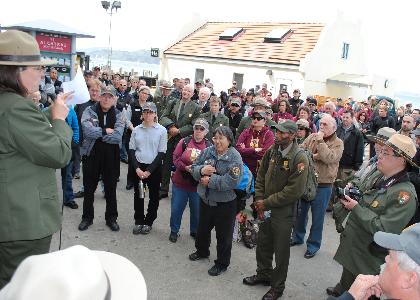 In other words, we did what we do best: provide the "Alcatraz Experience" on a silver platter. This time dished up to 3,000 people in 3 hours-whew! Pow Wow delegates were treated to our best-and they were paying attention! Heads swiveled as soon as they got off the ferries. They were all smiles when they saw our NPS and Conservancy representatives-and our primped and readied island. Welcomed by enthusiastic NPS personnel and marched up the hill to the tune of fully prepped and bright interpreters, they were met by the gleaming cell-house, scoured and stocked stores, gardens in bloom, and knowledgable volunteers. In other words, we did what we do best: provide the "Alcatraz Experience" on a silver platter. This time dished up to 3,000 people in 3 hours-whew! Pow Wow delegates were treated to our best-and they were paying attention! Heads swiveled as soon as they got off the ferries. They were all smiles when they saw our NPS and Conservancy representatives-and our primped and readied island. Welcomed by enthusiastic NPS personnel and marched up the hill to the tune of fully prepped and bright interpreters, they were met by the gleaming cell-house, scoured and stocked stores, gardens in bloom, and knowledgable volunteers.
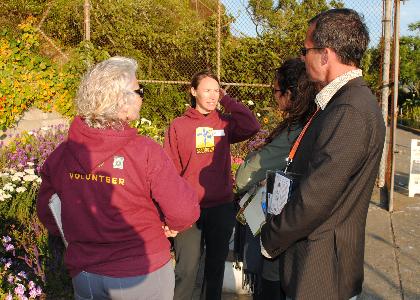 There was a panel of alumni for the "Real People Real Stories" showcase, California's finest wines from "Sip Sonoma", and...of course...YOU! As ambassadors for the island, you presented a positive attitude front and center, and were ready with directions, ready with facts, ready with a smile! There was a panel of alumni for the "Real People Real Stories" showcase, California's finest wines from "Sip Sonoma", and...of course...YOU! As ambassadors for the island, you presented a positive attitude front and center, and were ready with directions, ready with facts, ready with a smile!
Thank you so much to everyone! What we accomplished on the 22nd was a demonstration of committment to excellence by doing everything that it took to succeed in this herculean effort! The Pow Wow delegates noticed and the world noticed! Time for you to take a bow! BRAVO!
Kristen Elford, Parks Conservancy
Brandt's Cormorants: 300 Nesting Pairs So Far!
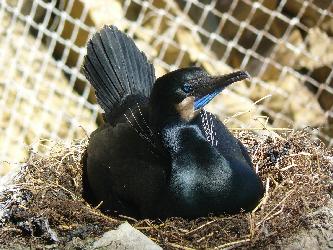 This month we feature one of our more sensitive seabird species: the Brandt’s Cormorant. This bird is native to the West Coast of the United States, living mainly between Southern California and Washington. The feather coloring of these birds depends upon the time of year. This month we feature one of our more sensitive seabird species: the Brandt’s Cormorant. This bird is native to the West Coast of the United States, living mainly between Southern California and Washington. The feather coloring of these birds depends upon the time of year.
During breeding season, April to August, Brandt’s Cormorants are covered in black feathers with blue iridescent throat patches, blue eyes, and white feather patches on their backs and behind their eyes. During the non-breeding season, the blue throat fades to a white patch and their eyes turn jet black.
In 2009, as many may remember, Alcatraz saw no breeding activity on the island by the Brandt’s, which gives us insight into what affects these birds. That year, El Nino reversed wind currents so that they carried waters from east to west (instead of west to east), affecting the rising of cold nutrient-rich waters. The lack of nutrients coming from the depths led to a decline in the populations of anchovies and sardines. As a result, many seabirds, Brandt’s Cormorants included, starved or could not rear their young. This year, we have about 300 pairs of birds currently nesting along our cliff sides, which indicate to us that food is plentiful enough for our population.
These birds are sensitive to disturbances such as human presence, loud noises, and boat activity. Their sensitivity makes their annual return to Alcatraz even more interesting. We receive a large number of visitors daily and see a lot of traffic by boats and helicopters, yet they continue to return. This phenomenon has interested biologists and has made Alcatraz a long-term monitoring site for Brandt’s Cormorants since 1995. Therefore, we have placed restrictions on various locations on the island to make sure that these birds are not disturbed. Access to the New Industries Building is limited to the south room and all visitors must sign in and remain 6 feet from the windows, including windows that are not roped off. Access to the model industries plaza is restricted to operations only.
Brandt’s are dependent upon water sources for food. They travel in large groups and dive to catch prey, primarily sardines, anchovies, and rockfish. Brandt’s can dive to depths of about 70 meters, which is equivalent to nearly 230 feet. As they dive, these birds snag fish and return to the surface of the water before eating their catch head first.
When did the cormorants first show up on Alcatraz? We have photographs showing the west side cliffs in the 1860s with small black dots that could easily be cormorants. It was in 1991 that we began to see them returning in large numbers and in 1995 monitoring of the colony began. Our colony of Brandt’s is tied with that in Ano Nuevo State Park as the second largest on the West Coast. In years when ocean conditions are right and food is plentiful, the population of breeding cormorants on Alcatraz can reach more than 1,500 pairs building nests, each raising between 3 and 6 young.
Our team encourages all of you to take a moment to travel along the west road to take a look at these birds. The first Brandt’s chicks of the year were spotted on May 18. In about 5-6 weeks, they should be learning to take flight and will then travel out to the open ocean along the Pacific coast-until they reach maturity in about four years and potentially return to Alcatraz to raise young of their own!
Lily Kelsey, NPS Intern
Escape of June 11, 1962
A Ton of Spoons
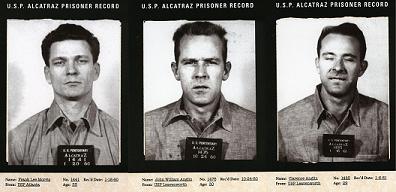 On June 11, 1962 three men slipped into the San Francisco Bay and were never seen again. Their escape has been immortalized in the movie Escape from Alcatraz, their story told to thousands of visitors to Alcatraz Island each day. How were these men able to disappear off of The Rock? On June 11, 1962 three men slipped into the San Francisco Bay and were never seen again. Their escape has been immortalized in the movie Escape from Alcatraz, their story told to thousands of visitors to Alcatraz Island each day. How were these men able to disappear off of The Rock?
It all started in Atlanta Federal Penitentiary; it was there that Frank Morris and John and Clarence Anglin, all bank robbers, first met and formed a bond, and where they met their fourth accomplice, Allen West. West was serving time for car jacking. All four men were career criminals and had been sentenced to Atlanta to serve hard time for their crimes.
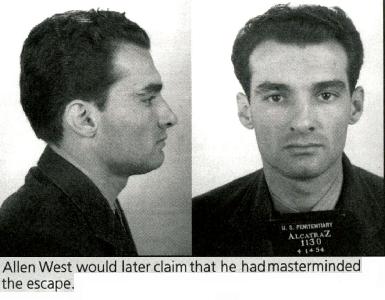 Frank Morris, a notorious escape artist, had spent most of his life in prison. He was first convicted of burglary when he was 13. He was sentenced to the National Training School for Boys in Washington, D.C. where his teachers described him as highly intelligent, but difficult to manage. Perhaps, if Morris had been born under different circumstances he could have used his high intelligence in a more constructive manner. Frank Morris, a notorious escape artist, had spent most of his life in prison. He was first convicted of burglary when he was 13. He was sentenced to the National Training School for Boys in Washington, D.C. where his teachers described him as highly intelligent, but difficult to manage. Perhaps, if Morris had been born under different circumstances he could have used his high intelligence in a more constructive manner.
Federal marshals decided that the pattern of escapes needed to end and by 1961 all four men were residing on Alcatraz Island. It was here that they formed a very elaborate plan for escape, which started to take shape by December 196. It involved fabricating dummy heads, creating life floats, vests, and using a variety of prison-made tools. It was common knowledge among inmates that there were several ventilation holes in the ceiling of C Block that had not been used for several years.
It was through those holes that West, Morris, and the Anglin brothers planned to escape. After discussing the various methods to escape from their cells, they agreed that the easiest method would be to dig through the ventilation grills in the back of their cells. John Anglin got a hold of the first spoon and started to dig his way out. Soon after, the other three men procured spoons and started digging as well. They served as lookouts for each other to avoid suspicion from the guards and took turns working on their cells. After nearly a month, each started to make good headway on their ventilation grills and had fabricated extraordinarily convincing fake ventilation grills that were undetected by routine cell checks. Meanwhile, the convicts started to create their "dummy heads" using soap, cotton, paint, and hair from the barber shop. Using glue stolen from the glove shop, the men used old military raincoats to fashion their life jackets and raft. After months of preparation, the convicts finally had all the necessary pieces.
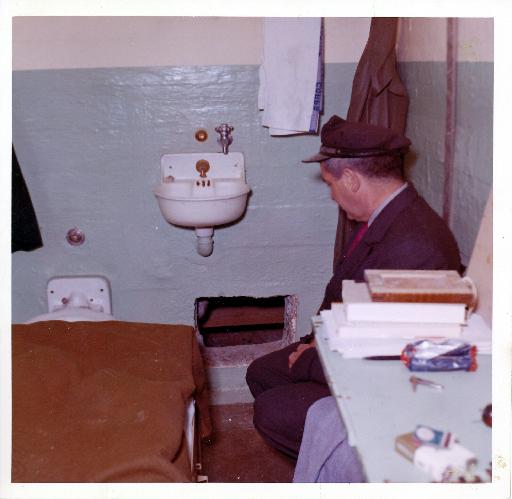 On the night of June 11, 1962, Morris indicated that the ventilator at the top of C Block was loose enough and announced that the escape would happen that night. At 9:30 pm, after lights out, the convicts put the dummy heads in their beds and crawled out the back of their cells. On the night of June 11, 1962, Morris indicated that the ventilator at the top of C Block was loose enough and announced that the escape would happen that night. At 9:30 pm, after lights out, the convicts put the dummy heads in their beds and crawled out the back of their cells.
All of the men, except West, successfully made it out. They climbed 30 feet up the plumbing to the cellhouse roof, traveled across the rooftop, and scaled down the piping to the ground. At 1:45 am, West was finally able to completely remove his grill, but by that time it was too late. That night was the last time anyone saw Morris and the Anglin brothers.
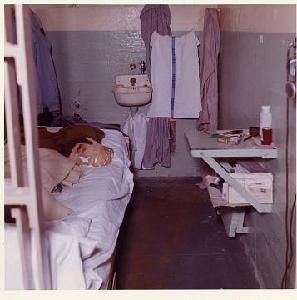 On the morning of June 12, 1962 at 7:18 am, Officer Barlett discovered Frank Morris was missing from his cell when he nudged what he thought was Morris’ head. When the head rolled to the floor, the officer realized that it was just a decoy. Alcatraz went into lock down and officers scoured the cellhouse and Bay for the missing convicts. The officers and FBI learned a great deal from Allen West about the escape plan. The FBI searched for the convicts for two decades; all possible leads were tracked down, but eventually led to nothing. On the morning of June 12, 1962 at 7:18 am, Officer Barlett discovered Frank Morris was missing from his cell when he nudged what he thought was Morris’ head. When the head rolled to the floor, the officer realized that it was just a decoy. Alcatraz went into lock down and officers scoured the cellhouse and Bay for the missing convicts. The officers and FBI learned a great deal from Allen West about the escape plan. The FBI searched for the convicts for two decades; all possible leads were tracked down, but eventually led to nothing.
Many historians still debate whether the escape was successful. There are several key clues that cast doubt on the success of the plan.First, one of the life vests found was covered in brown spots, later identified as blood, and showed teeth marks on the air valve. The convict wearing that vest had clamped down on the air valve to prevent it from leaking. This suggests very strongly that the inmate most likely drowned due to a malfunctioning life vest. Another life vest washed ashore at Cronkhite Beach with the clip missing and a small tear at the seam. Evidently their makeshift life vests did not preserve the convicts’ lives.
Second, on the same night a man named Seymour Webb jumped from the Golden Gate Bridge. Despite a quick response by the U.S. Coast Guard, his body was never recovered. Strong tides were in effect that night. Third, the temperature of the Bay waters is around fifty degrees. It would only take approximately 20 minutes before the water temperature would start to affect body functions.
Fourth, on July 17, 1962, a Norwegian freighter reported seeing a body floating 20 miles northwest of the Golden Gate Bridge. Using binoculars, they identified the body as being face down and wearing full-length denim trousers, identical to prison issue. No other person reported missing at the time was identified as wearing denim trousers. This body most likely was that of one of the escapees.
Fifth, no contact was made with any of the family members of Morris or the Anglin brothers. The Anglin brothers had discussed the possibility of escape with their family. Their family feels that if they made it, they would have been contacted at some point.
This June 1962 escape attempt is arguably the most famous attempt ever made on Alcatraz. Visitors to our national park hear the story every day and most arrive on the island with knowledge gleaned from the movie Escape from Alcatraz. As staff on Alcatraz Island, part of our job is to share its history with the thousands of visitors that arrive each year. I encourage each and every one of you to take some time to learn about the island. Knowledge of the resource can go a long way in making a lasting connection with our visitors. Remember, by sharing the history of the island you are creating stewards for the parks and thus preserving history for generations to come.
Teresa Williams, Historical Interpreter, Alcatraz Island
Bibliography
Esslinger, Michael. Alcatraz: A Definitive History of the Penitentiary Years. Ocean
View Publishing. Carmel, CA 2003.
Stuller, Jay. Alcatraz The Prison. Golden Gate National Parks Conservancy. San
Francisco, CA. 1998.
Safety-Gram!
You are really the answer! Whether or not you realize it, your mind is the key to the safety of Alcatraz. Every minute we make decisions; they are either conscious or they are not. When made consciously they often work out better than otherwise.
We all have total control of one thing-our own emotional state and our attitude towards life. If we ask “how can I be safe and how can I make this place safer?” we can and will make it a better and safer place to live and work.
None of us can control the weather, visiting public, buildings, or roadways and boats by ourselves, but together we can and do create a consciousness about safety in this place. Instead of saying “I can’t,” always reword it to “How can I?” Thanks!
Ranger Jayeson Vance, NPS Alcatraz Safety Coordinator
Water Tower Stabilization Project

The vision of the Golden Gate National Parks...is to preserve and enhance the natural environment and cultural resources of these coastal lands north and south
of the Golden Gate for the inspiration, education and recreation of people
today, and for future generations. - Brian O'Neill
As outlined in the First Annual Centennial Strategy for the Golden Gate National Recreation Area, 2007, the Alcatraz water-tower has been targeted for "repair and rehabilitation".
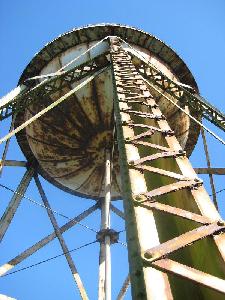 Built in 1941, it is "a 40-foot-diameter steel tank with a total capacity of 250,650 gallons." During the 1969 Native Occupation it became the canvas for Occupiers to transmit a message of peace and independence. The graffiti has become obscured by time and weather, but the message is still strong. Built in 1941, it is "a 40-foot-diameter steel tank with a total capacity of 250,650 gallons." During the 1969 Native Occupation it became the canvas for Occupiers to transmit a message of peace and independence. The graffiti has become obscured by time and weather, but the message is still strong.
Stabilization of the water-tower is scheduled to begin at the end of sea bird nesting season. Already there is a staging area in front of the tower where supplies sit. The final method(s) to use for the stabilization process are in discussion. The objectives of this project are:
1. Provide structural integrity of the water tower.
2. Provide corrosion resistant coatings.
3. Maintain historic appearance.
4. Increase life expectancy of the water tower by 20 years.
Alcatraz Island Water Tower Stabilization Project Scope of Work
Kristen Elford, Parks Conservancy
Structural Integrity: “Working to Win the War”
Last month "Structural Integrity" introduced the New Industries Building, including the events that precipitated its construction and a description of its “pilot phase” opening. This month Structural Integrity delves into how inmates working in the New Industries building contributed to the war production effort.
In the early 1940s the Navy, in an effort to protect the San Francisco Bay against incursion by enemy submarines, stretched a three-mile long anti-submarine net across the bay. This net stretched from Sausalito to the San Francisco Marina. Very large metal buoys kept the nets suspended, but they suffered from the effects of exposure to the elements. Inmates working in the New Industries Building were responsible for rehabilitating these buoys. In response to the Navy's need for cargo netting, a "Net Shop" was created in the New Industries Building. Convicts manufactured thousands of nets and earned commendation from the Navy for their work. Additionally, the first floor of the New Industries contained a "Tailor Shop" that produced inmate uniforms. As the war progressed, production in the "Tailor Shop" shifted and inmates worked diligently at the production of army uniforms.
Such diligent work did not go unnoticed. Warden Johnston instituted a new pay scale that allowed inmates to earn up to 12 cents an hour. In the 1940s when one did not have to pay for rent, groceries, utilities or medical care, 12 cents an hour could quickly develop into a respectable sum.
Indeed, Warden Johnston wrote favorably of the wartime work done by Industries inmates: “Regardless of what they have done or may do, I like to record and remember them at their best-when they were working to win the war.”
Mark Kaufman, NPS Intern
We Rocked the Night!
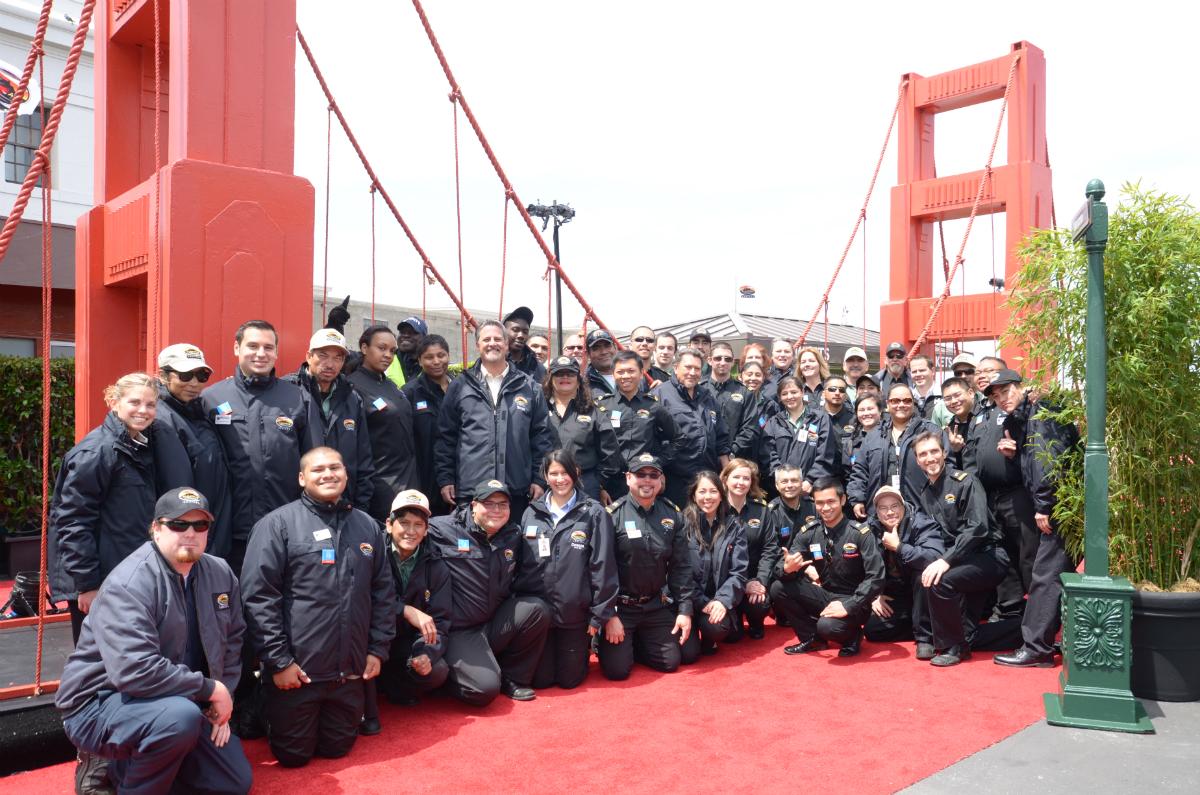 As a platinum sponsor to the opening night event for the 2011 U.S. Travel Association's International Pow Wow, Alcatraz Cruises, along with the National Park Service, Golden Gate National Parks Conservancy, Hornblower Cruises & Events and Pier 39, hosted "Rock the Night", which transported 3,000 "Pow Wow" delegates to Alcatraz Island. As a platinum sponsor to the opening night event for the 2011 U.S. Travel Association's International Pow Wow, Alcatraz Cruises, along with the National Park Service, Golden Gate National Parks Conservancy, Hornblower Cruises & Events and Pier 39, hosted "Rock the Night", which transported 3,000 "Pow Wow" delegates to Alcatraz Island.
San Francisco was chosen to host the 2011 U.S Pow Wow-an international marketplace for the travel industry, and the largest generator of visits to the United States. Thousands of tour companies, wholesalers, and travel buyers from around the world conduct business with suppliers (hotels, attractions, etc.) from the United States. At International Pow Wow, buyers and sellers are able to schedule appointments and meet face to face to form potential partnerships. This is the largest tradeshow of its kind with over 5,500 delegates in attendance, a record-breaking year!
Why record-breaking, you might ask? We believe it’s due to the conference being held here in our beautiful city. Tourism is the largest industry in San Francisco and 25% of our visitors are international. Hosting Pow Wow allowed San Francisco the opportunity to showcase its rich cultural diversity, spectacular sites, and famous landmarks. Overnight, the Alcatraz Landing at Pier 33 was dramatically transformed into “The Streets of San Francisco”, with live music, dancing, and performances. Guests were allowed to “taste” a few neighborhoods and enjoy live entertainment through Chinatown, Fillmore, Haight-Ashbury, North Beach, Japantown, and the Mission-Dolores District as they made their way to the vessel. Each guest had the red carpet treatment and we pulled out all the stops! They even had the opportunity to walk across a model of the Golden Gate Bridge-a great photo-op!
On Alcatraz Island, there were several interpretive programs conducted by experienced rangers throughout the Island. Former guards, inmates, and children who grew up on Alcatraz Island told their story of what life was like on The Rock. Sonoma County representatives were in the shower room showcasing a few vineyards with wine tasting. Hornblower’s San Francisco Belle was docked on Alcatraz with music on each of the three decks. Merchants and restaurants from world-famous Fisherman’s Wharf showcased their products on the main deck, the different Hornblower ports throughout California were represented on the second deck, and the National Parks Promotion Council occupied the third deck.
Despite the cold weather, our friends from around the world truly enjoyed themselves. They were allowed the opportunity to stroll through some of the wonderful neighborhoods of San Francisco and experience Alcatraz Island. With the great collaboration of all organizations involved, the event was a huge success and we all ROCKED THE NIGHT! See the slideshow (photos by NPS volunteer Ian Craig).
Lorelei Octavo, Alcatraz Cruises
Thank you to everyone who contributed!

|